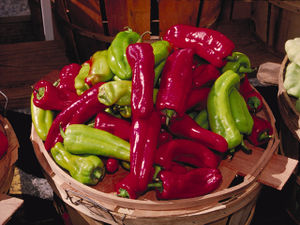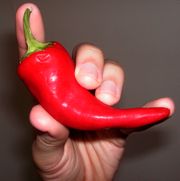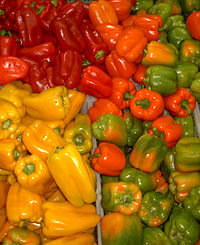Chili pepper


Chili pepper (from Nahuatl chilli, chilli pepper, chilli, chillie, chili, and chile) is the fruit[1] of plants from the genus Capsicum, members of the nightshade family, Solanaceae.
Chili peppers originated in the Americas. After the Columbian Exchange, many cultivars of chili pepper spread across the world, used in both food and medicine.
Contents |
History
Chili peppers have been a part of the human diet in the Americas since at least 7500 BC. There is archaeological evidence at sites located in southwestern Ecuador that chili peppers were domesticated more than 6000 years ago,[2][3] and is one of the first cultivated crops in the Americas that is self-pollinating.
Chili peppers were domesticated at least in different parts of South and Central America.[4]
Christopher Columbus was one of the first Europeans to encounter them (in the Caribbean), and called them "peppers" because they, like black and white pepper of the Piper genus known in Europe, have a spicy hot taste unlike other foodstuffs. Upon their introduction into Europe chilis were grown as botanical curiosities in the gardens of Spanish and Portuguese monasteries. But the monks experimented with the chilis' culinary potential and discovered that their pungency offered a substitute for black peppercorns, which at the time were so costly that they were used as legal currency in some countries.[5]
Chilies were cultivated around the globe after Columbus.[6][7] Diego Álvarez Chanca, a physician on Columbus' second voyage to the West Indies in 1493, brought the first chili peppers to Spain, and first wrote about their medicinal effects in 1494.
From Mexico, at the time the Spanish colony that controlled commerce with Asia, chili peppers spread rapidly into the Philippines and then to India, China, Korea and Japan. They were incorporated into the local cuisines.
An alternate account for the spread of chili peppers is that the Portuguese got the pepper from Spain, and cultivated it in India, as described by Lizzie Collingham in her book Curry.[8] Collingham states in her book that the chili pepper figures heavily in the cuisine of the Goan region of India, which was the site of a Portuguese colony (e.g., vindaloo, an Indian interpretation of a Portuguese dish). Collingham also describes the journey of chili peppers from India, through Central Asia and Turkey, to Hungary, where it became the national spice in the form of paprika.
In 1995 archaeobotanist Hakon Hjelmqvist published an article in Svensk Botanisk Tidskrift claiming there was evidence for the presence of chili peppers in Europe in pre-Columbian times.[9] According to Hjelmqvist, archaeologists at a dig in St Botulf in Lund found a Capsicum frutescens in a layer from the 13th century. Hjelmqvist thought it came from Asia. Hjelmqvist also said that Capsicum was described by the Greek Theophrastus (370–286 BCE) in his Historia Plantarum, and in other sources. Around the first century CE, the Roman poet Martialis (Martial) mentioned "Piperve crudum" (raw pepper) in Liber XI, XVIII, allegedly describing them as long and containing seeds (a description which seems to fit chili peppers - but could also fit the long pepper, which was well known to ancient Romans).
Species and cultivars

The common species of chili peppers are:
- Capsicum annuum, which includes many common varieties such as bell peppers, wax, cayenne, jalapeños, and the chiltepin
- Capsicum frutescens, which includes the chiles de árbol, malagueta, tabasco and Thai peppers
- Capsicum chinense, which includes the hottest peppers such as the naga, habanero, Datil and Scotch bonnet
- Capsicum pubescens, which includes the South American rocoto peppers
- Capsicum baccatum, which includes the South American aji peppers

Though there are only a few commonly used species, there are many cultivars and methods of preparing chili peppers that have different names for culinary use. Green and red bell peppers, for example, are the same cultivar of C. annuum, immature peppers being green. In the same species are the jalapeño, the poblano (which when dried is referred to as ancho), New Mexico (which is also known as chile colorado), Anaheim, serrano, and other cultivars.
Peppers are commonly broken down into three groupings: bell peppers, sweet peppers, and hot peppers. Most popular pepper varieties are seen as falling into one of these categories or as a cross between them.
Intensity
The substances that give chili peppers their intensity when ingested or applied topically are capsaicin (8-methyl-N-vanillyl-6-nonenamide) and several related chemicals, collectively called capsaicinoids.[10][11] Capsaicin is the primary ingredient in the pepper spray used as an irritant weapon.
When consumed, capsaicinoids bind with pain receptors in the mouth and throat that are responsible for sensing heat. Once activated by the capsaicinoids, these receptors send a message to the brain that the person has consumed something hot. The brain responds to the burning sensation by raising the heart rate, increasing perspiration and release of endorphins. A 2008 study[12] reports that capsaicin alters how the body's cells use energy produced by hydrolysis of ATP. In the normal hydrolysis the SERCA protein uses this energy to move calcium ions into the sarcoplasmic reticulum. When capsaicin is present, it alters the conformation of the SERCA, and thus reduces the ion movement; as a result the ATP energy (which would have been used to pump the ions) is instead released as heat.[13]
The "heat" of chili peppers is measured in Scoville heat units (SHU), which is the number of times a chili extract must be diluted in water for it to lose its heat. Bell peppers rank at 0 SHU, New Mexico green chilis at about 1,500 SHU, jalapeños at 3,000–6,000 SHU, and habaneros at 300,000 SHU. The record for the hottest chili pepper was assigned by Guinness World Records to the naga jolokia (from northeastern India), measuring over 1,000,000 SHU. Pure capsaicin, which is a hydrophobic, colorless, odorless, and crystalline-to-waxy solid at room temperature, measures 16,000,000 SHU.
Uses
Culinary uses

Chili pepper plant leaves, mildly bitter but not nearly as hot as the vegetables that come from the same plant, are cooked as greens in Filipino cuisine, where they are called dahon ng sili (literally "chili leaves"). They are used in the chicken soup, tinola.[14] In Korean cuisine, the leaves may be used in kimchi.[15] In Japanese cuisine, the leaves are cooked as greens, and also cooked in tsukudani style for preservation.
Psychology
Psychologist Paul Rozin suggests that eating chilis is an example of a "constrained risk" like riding a roller coaster, in which extreme sensations like pain and fear can be enjoyed because individuals know that these sensations are not actually harmful. This method lets people experience extreme feelings without any risk of bodily harm.[16]


Medicinal
Capsaicin is a safe and effective topical analgesic agent in the management of arthritis pain, herpes zoster-related pain, diabetic neuropathy, postmastectomy pain, and headaches.[17]
Irritant weapon
Capsaicin extracted from chillis is used in a spray as a non-lethal weapon.
Crop defence
Farmers in Africa and on the Indian subcontinent have found the use of chilis effective in crop defence against elephants. The chilis are spread on fences and other structures to keep the elephants away. Because the elephants have a large and sensitive olfactory and nasal system the smell of the chilli causes them discomfort and deters them from feeding on the crops. This can lessen dangerous physical confrontation between people and elephants.
Food defence
As birds have a lessened sensitivity to the effects of chili it can be used to keep mammalian vermin from bird seed (see Evolutionary Advantages below).
Nutritional value
| Nutritional value per 100 g (3.5 oz) | |
|---|---|
| Energy | 166 kJ (40 kcal) |
| Carbohydrates | 8.8 g |
| Sugars | 5.3 g |
| Dietary fiber | 1.5 g |
| Fat | 0.4 g |
| Protein | 1.9 g |
| Water | 88 g |
| Vitamin A equiv. | 48 μg (5%) |
| - beta-carotene | 534 μg (5%) |
| Vitamin B6 | 0.51 mg (39%) |
| Vitamin C | 144 mg (240%) |
| Iron | 1 mg (8%) |
| Magnesium | 23 mg (6%) |
| Potassium | 322 mg (7%) |
| Percentages are relative to US recommendations for adults. Source: USDA Nutrient database |
|
Red chilis contain high amounts of vitamin C and carotene (provitamin A). Yellow and especially green chilis (which are essentially unripe fruit) contain a considerably lower amount of both substances. In addition, peppers are a good source of most B vitamins, and vitamin B6 in particular. They are very high in potassium, magnesium, and iron. Their high vitamin C content can also substantially increase the uptake of non-heme iron from other ingredients in a meal, such as beans and grains.

Evolutionary advantages
Birds do not have the same sensitivity to capsaicin, because it targets a specific pain receptor in mammals. Chili peppers are eaten by birds living in the chili peppers' natural range. The seeds of the peppers are distributed by the birds that drop the seeds while eating the pods, and the seeds pass through the digestive tract unharmed. This relationship may have promoted the evolution of the protective capsaicin.[18] Products based on this substance have been sold to treat the seeds in bird feeders to deter squirrels and other mammalian vermin without also deterring birds. Capsaicin is also a defense mechanism against microbial fungi that invade through punctures made in the outer skin by various insects.[19]
Spelling and usage
The three primary spellings are chili, chile and chilli, all of which are recognized by dictionaries.
- Chili is widely used, although in much of South America the plant and its vegetable are better known as ají, locoto, chile, or rocoto. However, this spelling is discouraged by some in the United States of America, since it also commonly refers to a popular Southwestern-American dish (also known as chili con carne (literally chili with meat), the official state dish of Texas[20]), as well as to the mixture of chili powder and other spices used to flavor it. Chili, as in the case of Cincinnati chili, has come to be used for stews that do not actually contain any chile peppers. Chili powder and chile powder, on the other hand, can both refer to dried, ground chili peppers.
- Chile is an alternate usage, the most common Spanish spelling in Mexico,[21] as well as some parts of the United States of America and Canada, which refers specifically to this plant and its fruit. In the American Southwest (particularly northern New Mexico), chile also denotes a thick, spicy, un-vinegared sauce which is available in red and green varieties, and which is often served over most New Mexican food.
- Chilli was the original Romanization of the Náhuatl language word for the fruit (chīlli)[22] and is the preferred British spelling according to the Oxford English Dictionary, although it also lists chile and chili as variants."d
The name of the plant bears no relation to Chile, the country, which is named after the Quechua chin ("cold"), tchili ("snow"), or chilli ("where the land ends"). Chile is one of the Spanish-speaking countries where chilis are known as ají, a word of Taíno origin.
There is also some disagreement on the use of the word pepper for chilis because pepper originally referred to the genus Piper, not Capsicum; however this usage is included in English dictionaries, including the Oxford English Dictionary (sense 2b of pepper) and Merriam-Webster.[23] The word pepper is commonly used in the botanical and culinary fields in the names of different types of chili peppers.
References
- ↑ "HORT410. Peppers - Notes". Purdue University Department of Horticulture and Landscape Architecture. http://www.hort.purdue.edu/rhodcv/hort410/pepper/pe00001.htm. Retrieved 20 October 2009. "Common name: pepper. Latin name: Capsicum annuum L. ... Harvested organ: fruit. Fruit varies substantially in shape, pericarp thickness, color and pungency."
- ↑ Perry, L. et al. 2007. Starch fossils and the domestication and dispersal of chili peppers (Capsicum spp. L.) in the Americas. Science 315: 986-988. Link.
- ↑ BBC News Online. 2007. Chillies heated ancient cuisine. Friday, 16 February. Available from: http://news.bbc.co.uk/2/hi/americas/6367299.stm. Accessed 16 February 2007.
- ↑ Bosland, P.W. 1996. Capsicums: Innovative uses of an ancient crop. p. 479-487. In: J. Janick (ed.), Progress in new crops. ASHS Press, Arlington, VA.
- ↑ TheNibble Online Specialty Food Magazine. Chile Pepper Glossary. August 2008. Available from: http://www.thenibble.com/reviews/main/salts/scoville.asp. Accessed 31 August 2010.
- ↑ Heiser Jr., C.B. 1976. Pp. 265-268 in N.W. Simmonds (ed.). Evolution of Crop Plants. London: Longman.
- ↑ Eshbaugh, W.H. 1993. Pp. 132-139 in J. Janick and J.E. Simon (eds.). New Crops. New York: Wiley.
- ↑ Collingham, Elizabeth (February 2006). Curry. Oxford University Press. ISBN 0-09-943786-4.
- ↑ Hjelmqvist, Hakon. "Cayennepeppar från Lunds medeltid". Svensk Botanisk Tidskrift, vol 89: pp. 193-.
- ↑ S Kosuge, Y Inagaki, H Okumura (1961). Studies on the pungent principles of red pepper. Part VIII. On the chemical constitutions of the pungent principles. Nippon Nogei Kagaku Kaishi (J. Agric. Chem. Soc.), 35, 923–927; (en) Chem. Abstr. 1964, 60, 9827g.
- ↑ (ja) S Kosuge, Y Inagaki (1962) Studies on the pungent principles of red pepper. Part XI. Determination and contents of the two pungent
- ↑ Journal of Biological Chemistry, 2008, 283, 21418
- ↑ Hot News about Chili Peppers, Chemical & Engineering News, 86, 33, 18 Aug. 2008, p. 35
- ↑ http://www.tribo.org/vegetables/dahongsili.html tribo.org
- ↑ Untitled Document
- ↑ Paul Rozin1 and Deborah Schiller, Paul; Schiller, Deborah (1980). "The nature and acquisition of a preference for chili pepper by humans". Motivation and Emotion 4 (1): 77–101. doi:10.1007/BF00995932.
- ↑ [1]
- ↑ Tewksbury, J. J. and G. P. Nabhan. 2001. Directed deterrence by capsaicin in chillies. Nature412:403-404.
- ↑ John Roach (11 August 2008). "Fungus Puts the Heat in Chili Peppers, Study Says". Discover Magazine. http://news.nationalgeographic.com/news/2008/08/080811-chili-bugs.html. Retrieved 2008-08-13.
- ↑ State Symbols - Texas State Library
- ↑ Heiser, Charles (August 1990). Seed To Civlization: The Story of Food. Cambridge: Harvard University Press. ISBN 0-67-479681-0.
- ↑ A Brief History of Chilies : Kakawa Chocolate House, Mesoamerican Mayan Aztec Drinking Chocolate, Historic European and Colonial American Drinking Chocolate, Truffles and More
- ↑ va=pepper - Definition from the Merriam-Webster Online Dictionary
External links
- Better Homes & Gardens guide to Chillies
- Plant Cultures: Chilli pepper botany, history and uses
- The Chile Pepper Institute of New Mexico State University
- Capsicums: Innovative Uses of an Ancient Crop
- Chile varieties database
|
||||||||||||||||||||||||||||||||||||||||||